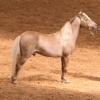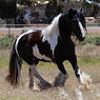Copper deficiency
Forums
Re: Copper deficiency
looks silver black on my screen
I had a sport horse that was copper deficient , the vet gave him a copper injection , it caused a large lump in his neck which made him stiff and he couldnt flex properly , it took over two years to go away , Ive asked about loose minerals over here but the feed stores have no idea what Im talking about
Re: Copper deficiency
Woah! First picture, clearly looks Silver Black. But then the second photo I thought Palomino, so thought maybe it was sooty. That is just trippy....>_> It makes me want to do experiments!...so then which one would be his natural color? That second one is just so strange for silver black.
Re: Copper deficiency
I was just reading about this...in my farrier books no less. One book says that in the study they document that almost ALL the chestnuts in the study required double the normal recommended amount of copper to get them back to normal readings in their bloodwork.... Hear that ever?
Because, I'm contemplating getting the seperated minerals rather than the complete ones as there is too much iron in them with my pasture estimate on turn out for 14-16 hours per day and not enough copper for any horse.....and iron will seriously mess with the Ca / Ph ratio because it inhibits absorption of one of the two (CRS).
Re: Copper deficiency
Yeah I don't think we have a copper problem here in Florida? I've never heard of it at least, but that's not to say it isn't a problem. Only horses I ever had to give supplements to were for this dressage barn. I was in charge of feeding and medicating, but the majority of supplements came as smart packs so it was just a simple open and dump process.
Re: Copper deficiency
I had my ponies one year on a property that was known for copper, so plenty of copper. It was in the water and some people didn't like using copper pipes as they thought that might give them too much copper etc.. Anyway you should have seen the ponies that year, they looked awesome!!!! The chesnuts because SO much richer, my blacks were all, bar one, VERY black, the black silver was darker chocolate than the pony in the first post. I've seen her now, since I sold her and she's gone or more silvery dappled colour again. They all looked really cool I thought! A few years later after being on a different property, still shiney coats, but just not the same. It probably wasn't just copper, but copper was something the region was known for, so..?
Re: Copper deficiency
[quote="accphotography"]I really want to do this... I wonder what Lace would look like. I wish there was a way to know what she really needs.[/quote]
My problem is that I feed hay every night in the stall and it's not always from the same batch/load. I think what I will do this year is try to get a load and fill my hayloft (PITA), have it tested, continue to test the pasture, and then have their bloodwork done to see where they are all at.
But having her blood work done would give you an idea of where she's at. Now I'm reading that a lack of copper will disturb the ability to absorb iron which in turn messes up Ca and Ph. All tied together it seems!
The normal range for blood copper concentrations in horses is 16.4 - 27.9 mol/L.
Re: Copper deficiency
[quote="accphotography"]Well she only gets hay that's cut there on the farm, so it's the same stuff she's eating in the field. It would be easy to test those two sources. I have to do it anyway in a few months for the fescue endophyte.[/quote]
if it does have that particular fescue in it, are you shipping in hay or just doing the domperidone (or do they have another drug out for this by now?)?
Re: Copper deficiency
They still use domperidone. She's due March 31st. Our grass generally doesn't come in until around March 15th or later. So she won't have much time on the grass (we have no dry lot and I'd rather not stall her full time). Our only grass at the farm, as I mentioned, is cut there so should be the same as her field... I could bring in hay (in this area I am 100% certain the local feeds shops will have tested endophyte free hay), but I'm not certain it's necessary. I have a friend whose vet suggested just putting the mare on domperidone the last 30 days, I'm thinking we may just do the same. I haven't actually talked to our vet about it yet and she knows this area and foaling better than I do so she may have a different thought, but it seems to me like that course of action should do fine.
Re: Copper deficiency
in my college mare care/foal watch class they knew about the fescue...completely burned out their fields, replanted, tested, came back...burned out fields, replanted, tested...it came back. They ended up buying outside hay from a source they'd used the previous years....bad year, it had that fescue in it.
It was a horrible foaling season...the last handful of mares that were on the domperidone for the last weeks did fine (we had one that we started 3 weeks before she foaled...she went 2 weeks early..she was fine too). But man....after seeing in person what a type of grass can do..*dies* That was my first, second and third experience dealing with a red bag birth (two of those three babies did survive though!!!), and then there were other complications too...but man. They are now so paranoid about their hay, they pull a sample from a lot of the bales they haul in, and then still give the domperidone the last month. Can't say that I blame them...before that year, they had a few other foal seasons like that and they didn't know why at the time.
Re: Copper deficiency
Totally understandable. It's a scary thing. They can be saved alot of the time, but a person pretty much HAS to be there in a timely fashion, and that's just not always possible.
I don't know a whole lot about it, but I can see no reason in a case like mine why just giving domperidone for the last month and maybe limiting her intake of obviously bad stuff could hurt.
Re: Copper deficiency
you'll probably be safe...these mares were still eating this fescue hay when on the domperidone and it still worked out great for them :)
It was scary on the red bags and stuff...we were doing hourly checks on the mares and found those three ASAP...there were two others that had red bag births, other students were on mare watch at that point though. Sad as it was, it was a learning experience too....not one you really want to have though.






Re: Copper deficiency
big difference! is she a sotty pally or a silver black ?